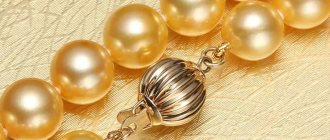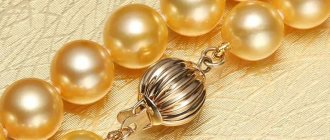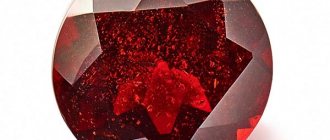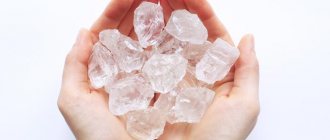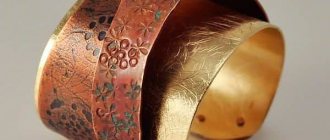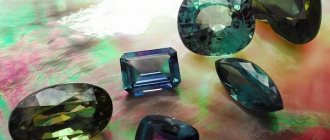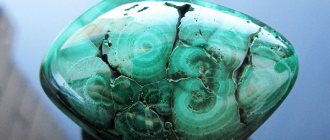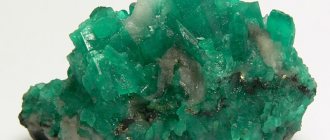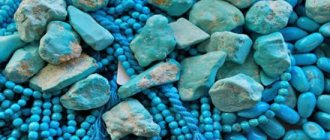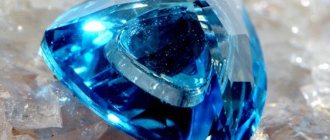Amethyst: description and characteristics
Amethyst is a precious variety of natural quartz that comes in pink, lavender and purple hues. In rare cases, gems of green, blue and black are found. Such specimens are highly valued among jewelers and collectors.
In nature, the mineral is formed in the form of crystals with different levels of transparency. The color saturation of the stone depends on iron impurities. When heated strongly, it becomes colorless, most often permanently changing its color after cooling. The mineral also loses its color when exposed to direct sunlight - approximately 10% over 5 years of daily wear.
Amethyst is a fairly hard gem (7 out of 10 on the Mohs scale); in jewelry it is valued for its flexibility in processing. In lithotherapy, it is used to treat insomnia, calm the nervous system, and relieve alcohol addiction.
How to determine if an amethyst is natural
Currently, there are a huge number of amethysts and jewelry with them on sale in various online stores, online auctions, and even in regular jewelry stores. Rumor gives amethysts such qualities as absolute availability, prevalence and low cost. This opinion is quite correct for small-sized stones and very erroneous for large amethysts weighing more than 15-20 carats. Amethysts over 50 carats can be considered rare, while amethysts over 100 carats can be considered very rare gemstones. It is for this reason, and also because more than 90% of all large amethysts not only on the Russian but also on the world market are outright synthetics, and also as an answer to numerous questions received, this material was prepared.
Amateur methods:
1. Coloring. If even slight unevenness in color is invisible to the naked eye (for fairly large stones), the stone is more likely to be synthetic than natural. If a stone has a noticeable “Alexandrite” effect of changing color under different lighting conditions, the stone is more likely to be synthetic than natural.
2. Temperature sensations. Amethyst, like any natural quartz, is always cold to the touch. Natural stone has lower thermal conductivity. If you have a guaranteed natural or guaranteed synthetic amethyst on hand, then you can time the heating time of the stone in your fingers, or “on your cheek”. Synthetic amethyst will heat up faster, even if it is set.
3. Water test. When placed in water, natural amethyst becomes noticeably discolored along the edges. Synthetic - no.
4. Visible cleanliness. In comparing two stones (synthetic and natural), provided that both are clean to the eye, the synthetic one looks much more transparent. Natural, even the purest, will look a little “cloudy” in this comparison.
5. UV test. Under a source of ultraviolet radiation, natural amethyst discolors evenly, while synthetic amethyst discolors in patches.
6. A very bright and very saturated color should definitely make one suspect that it is synthetic and indicates the need for verification.
7. If the stone (if possible to look and see) girdle , the stone is natural. Synthetic amethysts always have a polished girdle. Also, with high-quality cutting, the girdle of natural amethyst can be polished.
Professional methods:
How a microscope can help:
You can use a jewelry microscope, but naturally, a gemological (immersion) microscope is better and provides more opportunities.
1. The absence of inclusions visible under a microscope clearly indicates the synthetic nature of the stone.
2. The presence of only gas inclusions of irregular, ragged shape (“bread crumbs”) visible under a microscope clearly indicates the synthetic nature of the stone.
3. Natural amethyst is never free of inclusions. Inclusions indicating the naturalness of amethyst:
— Microtubules (microtubules), located circumferentially along the crystal growth zones, interrupted by bridges. In principle, such inclusions do not exist in synthetic amethysts;
— Liquid inclusions in the form of normal liquid bubbles. They can be easily identified even under a jewelry microscope when illuminated with a highly focused beam. Passing through a liquid bubble, the beam will noticeably “break” and exit the bubble at an obtuse angle;
— Gas-liquid inclusions in the form of bubbles of a regular, round-oval shape. Sometimes it is possible to notice a liquid phase in such a bubble, but most often such a bubble is filled with supersaturated vapor. It can be easily identified by changes in light refraction, but only under an immersion microscope;
— Natural cracks (rarely found in high-quality stones) can usually consist of both gas and gas-liquid inclusions. Identified under an immersion microscope. Outwardly, such cracks resemble the same tubules, only larger, and located in exactly the same way.
Anyone can find high-quality images of typical inclusions in amethysts in published atals of inclusions (along with the accompanying books, which are both luxurious and expensive), or on the Internet.
4. Color zoning. Natural amethyst is never evenly colored. This is due to the fact that natural amethyst is invariably represented by separate crystalline twin individuals, which are alternately right-handed and left-handed crystals. In some crystals, in a section perpendicular to the edge of the prism, you can see triangular sectors, which are represented by alternating right- and left-handed quartz and have different colors - violet and white. Zoning is usually clearly visible under a microscope. In the case of very light stones, if the zoning is invisible, you can turn on the inversion mode (the image is displayed as a negative). Dark areas on a light background are easier to see than light areas on a dark background.
If zoning is not visible even with inversion, the stone is synthetic, which will certainly be confirmed by the nature (or absence) of inclusions.
A separate question is how to examine a stone under a microscope if it is already in a frame... This is also possible. To do this, you will need an external highly directional light source that allows you to “illuminate and illuminate” the stone in any direction. As such, you need to use a powerful gemological flashlight with a flexible fiberglass nozzle, which allows you to “get inside the products and illuminate from the inside.” A stone that is firmly mounted in a frame, without any gaps, cannot be illuminated from the right side, and identification is much more difficult, if not impossible. That’s why gemologists don’t like to check them.
How spectral analysis can help:
Without exception, all quartz, and amethyst too, have goethite inclusions. Sometimes they are large enough to be seen under an optical microscope. Then needle-shaped inclusions, like rutile ones, will be visible. Quite often, the size of goethite microinclusions is so small that they can only be seen in an electron microscope image. But there are always enough of them to identify characteristic peaks on the spectrum. For example, in an IR spectrogram of diffuse reflection using the Fourier method, the presence of bands with maxima at 630, 1130, 1660, 2800 and 3150 cm-1, which correspond to goethite - FeOOH, will be noticeable.
X-ray structural analysis will also provide unambiguous information about the natural or synthetic nature of the sample. It is known that in natural amethyst the chromophore is the Fe 2+ ion. But it is always accompanied by a certain amount of Fe3+ ions. Their number can vary from a few percent to tens of percent, but they are always there. X-ray diffraction analysis of synthetic amethyst will only show the presence of Fe2+ ions.
But the absorption spectrum with the presence of rutile (titanium dioxide) lines cannot be evidence of either naturalness or syntheticity. The fact is that it is in titanium crucibles that synthetic amethysts grow, into the mass of which microparticles of titanium dioxide can fall.
Origin story
Amethyst stone is translated from ancient Greek as “not drunk.” There is a beautiful legend associated with this name.
The god of winemaking and fun, Dionysus, fell in love with the beautiful nymph Ametis, who did not reciprocate her drunken suitor's feelings. Then the offended Dionysus decided to take the beauty by force. She could not escape from him and prayed to the goddess Artemis for help. She saved the nymph by turning her into stone. Dionysus immediately repented and poured wine on the stone, hoping to revive the beauty, but this did not happen. So the nymph became a beautiful purple mineral, endowed with the property of protecting people from drunkenness.
Professional methods for determining the authenticity of amethysts
Expert gemologists who study the physical properties of precious and semi-precious stones, their composition, value and cutting technology use special methods. With their help, you can accurately determine the origin of an amethyst:
- Ultraviolet radiation is the simplest and most accurate way to determine the authenticity of a stone. Natural amethyst becomes completely discolored under UV rays, while artificial stone discolors in separate areas.
- If color zoning is not visible to the naked eye, it is easily determined under a jewelry microscope. Natural amethysts always have dark and light areas.
- Spectral analysis. All quartz rocks, including amethyst, include particles of goethite. No matter how small they are, they can always be seen on an IR spectrogram.
- X-ray diffraction analysis.
- Natural cracks characteristic of natural stones are identified using an immersion microscope.
Varieties of amethyst
Jewelers divide amethysts into different types, depending on color:
- A classic purple stone, it is found in light lavender and dark purple shades. One of its rare varieties, “Deep Siberian,” combines purple with a dash of red.
- The natural green gem (praseolite) can only be found in Brazil. The price for such specimens is very high. They are characterized by needle-shaped inclusions.
- Black amethyst is the rarest and most mysterious type of mineral. Its deposits clear the surrounding area of radiation. It is believed that this gem has powerful energy, which is used by magicians and sorcerers in their rituals.
The variety of shades of stone depends on the oxidation processes of iron and manganese, and the interaction of iron with aluminum.
What does natural stone look like?
This violet-colored mineral is often counterfeited due to its popularity. It is worth knowing its true appearance and qualities.
The mineral has a purple color with different intensities of shades: from light lilac translucent to dark purple. The price of the product directly depends on the degree of color saturation.
Green minerals are found. Here you need to take into account that they are very rare, and under the guise of green amethyst, burnt quartz is most likely displayed on the store counter. The true green gem only comes from Brazil or the USA. It is not mined anywhere else.
You can recognize whether the stone in front of you is natural or artificial without resorting to complex procedures.
Types of fakes
Under the guise of a natural gem, various counterfeits are often offered:
- Colored plastic is the cheapest and lowest quality fake of amethyst, which can be visually distinguished even by a layman.
- Glass crystals, painted in the desired shade. In this case, it is more difficult to detect imitation. Glass is very fragile and susceptible to scratches
- Artificial amethysts grown on the basis of quartz. The synthetic specimen is practically no different in appearance from its natural original, but it lacks healing and magical properties.
- Inexpensive natural minerals that look like amethyst. Most often, cheaper fluorite, anthozonite, and inexpensive types of quartz, additionally colored and fired in a kiln, are passed off as a precious gem.
FLUORITE
Unlike other more expensive gemstones, amethyst is not always issued with documents confirming the authenticity of the stone. Therefore, to avoid substitution, you need to know how to distinguish an amethyst from a fake yourself.
What is used as a material for making counterfeits?
To make simple fakes, plastic and glass are used. Such samples are easy to distinguish from natural ones. Artificial crystals are less common in jewelry. High-quality counterfeits are not always detected even in laboratories. Sometimes other natural stones are passed off as amethyst.
Artificial crystals
The technology for growing synthetic amethysts began to be actively used only in the last 10 years. This was first done at the Lebedev Physical Institute in Moscow. Even large specimens are grown there, the diameter of which reaches 20-30 cm.
You can distinguish an inexpensive imitation thanks to the gap: the stone will lack inclusions characteristic of amethyst. It will be completely homogeneous. However, high-quality artificial crystals look like natural ones. In this case, the authenticity of the stone can only be determined in a laboratory way.
Glass
Glass counterfeits are most often used in cheap jewelry. It is not advisable to insert such a stone into a gold frame. Glass samples can be scratched even with a knife. They do not leave marks on porcelain. The fake has a uniform color and no inclusions.
Plastic
Plastic imitations are the crudest; even a person with no experience can distinguish them from the original. Such a fake easily heats up and scratches. It weighs little, and jewelry with it has a low price.
Cheap natural stones
Quartz and fluorite are sometimes passed off as amethyst. The first is irradiated with cobalt to give it a purple color. This imitation is characterized by instability of color.
The fake loses color when heated, even at home or in the sun. Fluorite has a similar hue, but is softer than amethyst. It can be scratched with a knife. Less commonly, synthetic chrysoberyls, cubic zirconias, spinels and sapphires are passed off as natural stones.
Under the sun's rays the stone will change color.
How to distinguish real from fake?
To verify the authenticity of an amethyst, you need to pay attention to the following characteristics:
- Brightness and color of the stone. This mineral is distinguished by a noble color palette, uneven coloring, and slight turbidity. A fake can be recognized by its brighter, “screaming” colors and impeccable transparency of the product.
- The structure of the gem. Air bubbles, microcracks, and needle-like inclusions are visible in a natural crystal. Glass and plastic fakes are distinguished by a perfectly smooth surface and an absolutely uniform structure.
- Density of the mineral. Natural stone is so hard that it will withstand the impact of any sharp object. If after checking there are small scratches left, it means it is a fake.
There are also ways to distinguish natural amethyst from synthetic:
- warm it in your palms - a natural stone will remain cold in your hands for a long time, an artificial one will quickly heat up;
- put it in a glass of water - a natural gem will have blurry outlines in the water, while an artificial gem will have a clearly defined outline;
- bring it into bright light - real amethyst will become uniformly colorless, unlike synthetic amethyst.
To be sure of the authenticity of the stone, it is better to buy amethyst from certified jewelry stores.
Checking the authenticity of the stone
Mineral identification methods vary in complexity, use of tools, and degree of reliability.
Visual assessment
You can distinguish a real amethyst by the following characteristics:
- not a particularly bright shade;
- uneven coloring;
- non-absolute transparency;
- inclusions of air, water, and microcracks are visible in the structure.
Synthetics are always bright, clean, evenly colored.
Color
In natural stone it is violet, lilac, lilac - from pale to deep dark, with a bluish or reddish tint. A special case is green amethyst, or prasiolite. It is rare; burnt quartz usually goes under this brand. When buying such a gem, they carefully study the documents - its homeland can only be Brazil and the USA.
Light mode
A simple, reliable way to distinguish a natural gem from a fake. The pebble is compared by color in the shade and in bright sun. If the original shade does not change when the light changes, the stone is natural.
Strength
The elegant violet-colored pebble is harder than steel, with a Moss scale rating of 7. This means that it is impossible to scratch it, for example, with a steel knife. Or try to pick off a piece. But amethyst itself easily scratches glass or porcelain.
This method easily identifies glass or plastic counterfeits. However, it is problematic to distinguish natural amethyst specimens from artificially grown ones - the strength characteristics of both are identical.
Thermal influence
The classic method for checking the naturalness of a gem. Natural amethyst, like any stone, has low thermal conductivity, so it heats up slowly.
The sample is picked up or applied to the body. If it doesn’t heat up almost immediately, it’s real.
The task will be simplified if you compare two samples at the same time. The origin of at least one of them must be known exactly, that is, whether it is natural or artificial. The difference in heating time will be the determining factor, and the result will be reliable.
Water test
A simple reliable method. The sample is placed in water. If the stone is natural, after a minute or two its edges will look slightly faded. An artificial mineral does not reproduce this visual effect; the pebble looks evenly colored along the contour and inside.
Ultraviolet
If possible, place the sample under an ultraviolet lamp. Natural amethyst is distinguished from artificial amethyst by the nature of the changes. A natural crystal will fade completely and evenly, while a synthetic crystal will fade partially and patchily.
A natural source of ultraviolet rays - the sun - will give a similar result. The pebble is examined on the street in clear weather.
Microanalysis
The method is simple, but requires scrupulousness and tools. When carefully examining a sample under a magnifying glass, loupe or microscope, a natural one will reveal the microscopic presence of gas or liquid bubbles and microcracks. Synthetic amethyst is free of such “defects”. It is easier to grow a pure crystal than with inclusions that imitate natural ones. Only curved grooves are visible in it - crystal growth lines, which are not found in natural gems.
A real amethyst is not evenly colored, since it consists of individual crystals, lighter or darker. The method for analyzing such zoning under a microscope depends on the color of the stones. For dark specimens, the device operates as usual. To view the light colors, turn on the inversion mode, that is, negative. If zoning is not visible in both cases, it is synthetic.
You can see the stone in the frame if it is not solid. To do this, a local light source is installed, precisely aimed at the sample.
How to counterfeit
Amethyst is a valuable variety of quartz. The most common fakes are stones grown artificially in laboratories. It is a mistake to believe that this is a fake, since a synthetic gem has the same properties as a natural one. The only difference is that one mineral was grown by nature, and the other by chemists.
In addition, among the fakes you can find beautiful stones that are made from:
- glass;
- plastic;
- cheap natural stones that are of less value.
Amethyst magic
Real Quartz:
- helps control negative emotions;
- promotes the achievement of peace and tranquility;
- develops a person’s personal capabilities;
- gives more self-confidence and courage;
- protects against thoughtless actions and deeds;
- harmonizes family relationships;
- predicts the weather (before rain and gusty winds it darkens, and in sunny weather it becomes lighter);
- helps to concentrate during meditation;
- is a powerful talisman against evil fate;
- enhances creative thinking.
The crystal will have to be kept with you regularly, only then will it actually fulfill its magical and healing properties.
Still, we should not forget that this quartz quickly changes its state. If you keep it with you during disagreements at work or discord with household members, the stone can attract negative vibes and begin to transfer them to its owner. Therefore, after all sorts of unpleasant conflicts with people, a product with an amethyst needs to be washed for some time under water so that the stone calms down.
What are analogues made from?
Amethyst is one of the most popular gemstones. Its name comes from the Greek “amethyst,” which means “not drunk,” which is why many people attribute magical and healing properties to it. It is for them that the naturalness of this crystal is fundamentally important. Fake stones are made from:
- plastic;
- glass;
- cheap or defective natural stones;
- tinted crystal.
Synthetic amethyst can hardly be called a fake, since it is grown artificially from the same mineral as the original. Natural amethyst differs from a fake in that it contains gas-liquid inclusions and small cracks. These defects are almost invisible to the naked eye, but give the stone a special beauty.
Amethyst treatment
The crystal is a stone of harmony and tranquility, resolving conflicts, freeing people from negative emotions and thoughts. Real quartz is a symbol of peace, love, sincerity, and sincerity.
In practice, it has been proven that quartz:
- relieves stress;
- improves brain activity;
- cleanses the blood;
- helps increase energy levels;
- normalizes the endocrine system;
- has a sedative effect on the nervous system;
- corrects blood circulation;
- rationalizes mental abilities;
- removes speech defects;
- creates harmony in the levels of one’s own consciousness;
- helps the formation of intelligence and multifaceted improvement of the individual;
- treats migraines;
- protects against skin diseases;
- speeds up metabolism;
- cures insomnia;
- relieves headaches that appear as a result of nervous exhaustion and excessive mental and nervous stress;
- helps with conception;
- treats addiction to alcohol;
- serves as an antidote to alcohol poisoning.
Quartz makes it possible to overcome the craving for alcohol. For this:
- drink water steeped with amethyst;
- apply the crystal to the surface of the chest.
The ancient Romans placed the crystal in a bowl of alcohol, as they believed that it would protect against excessive alcohol consumption and destroy the effects of toxic substances.
Main conclusions
Amethyst is one of the most visually attractive stones. At the same time, it is quite affordable from a financial point of view. However, this does not stop numerous “masters” trying to sell glass or transparent plastic under the guise of this gem.
- This variety of quartz is characterized by a deep, dark purple color that may reflect slightly under artificial light.
- Most often, synthetic crystals and anthozonite are passed off as natural amethyst.
- A natural mineral can be distinguished by its thermal conductivity, strength, weight and transparency.
- Professional evaluation includes ultraviolet, x-ray and spectral analysis.
Jewelry with amethyst can leave few people indifferent. This crystal is often combined with other valuable stones, which is why it is so important to learn how to identify a fake before purchasing a product.
